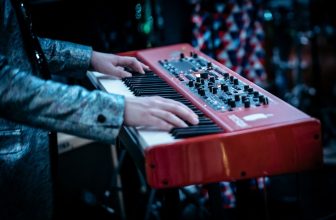
A harpsichord is a keyboard instrument that has a sound that is distinctly different than the piano. First things first, let’s compare and contrast the two instruments!
Harpsichord Vs. The Piano
Here are some differences between the harpsichord and the piano:
- Harpsichords strings are plucked
- Piano strings are struck
- Harpsichords have a different timbre– One that is much more cutting than the piano
- The piano tends to be more mellow timbred
- Harpsichord keys are black on white
- Piano keys are white on black
One easy way to tell a harpsichord from a piano is by looking at the keys. Many harpsichords have inverted colored keys- Black keys and white accidentals. On the inside, harpsichords have plectrums that pluck the keys, whereas pianos have hammers that strike the keys.
Another difference is that harpsichords have two keyboards stacked on top of one another (like many organs do), whereas pianos usually only have on keyboard with up to 88 keys.
Here are some similarities between the two instruments:
- Instruments are keyboards that have multiple strings per note inside
- Both instruments also have soundboards
Harpsichords and pianos are typically made with a wooden base, have a soundboard, and contain multiple strings tuned to the same note )and assigned to the same key) which makes them sound rich and full.
How the Harpsichord Came to Be
If you’re looking to learn more about the history of the harpsichord, you’ve come to the right place. The harpsichord was first developed in Western Europe. According to Cambridge.org, the first harpsichord was created by a man named Hermann Poll in 1397. He called the instrument the ‘clavicembalum’. The clavicembalum/ harpsichord had many string ancestors, such as the hammer dulcimer, and before that, the psaltry. These instruments look eerily like an opened up harpsichord/ piano! Take a peek at a Venetian harpsichord below:

Instruments Similar to the Harpsichord
- Virginals
- Spinets
Virginals are small square-shaped keyboard instruments with plucked strings. The main difference between virginals and the harpsichord is that virginals only had one string for each note. Another thing to note is that these strings were parallel to the keyboard This type of instrument is very old, and may very well be the first ancestor of the harpsichord.
Spinets or spinet pianos are a very small type of harpsichord-type instrument. Like virginals, spinets also only had one string per note. Unlike virginals, many spinets were wing-shaped and looked more like a piano.
You might be wondering what the point of making all of these different versions of instruments is. Here’s the (short) answer: Tone color! The most minute different in the way an instrument is built will change the overall sound.
Harpsichord Composers/ Pieces
The following composers are known for their works for harpsichord:
- Jean-Phillipe Rameau
- Johann Sebastian Bach
- Francois Couperin
- George Frederich Handel
- Domenico Scarlatti
If you already know a bit about the harpsichord, it’s likely that you’ve heard a Baroque piece written for the instrument. The harpsichord was one of the most commonly used instruments in the late Renaissance through the Baroque period.
Let’s check out some of the pieces written for the harpsichord:
- The Harmonious Blacksmith (George Frederich Handel)
- Concerte Champetre (Francis Poulenc)
- Sonata K2 (Domenico Scarlatti)
The Harmonious Blacksmith is the last movement of a theme and variations piece by Handel. It was written in 1702. You may have heard this piece for piano or even the version that has been rearranged for a brass ensemble, or full wind band.
Katarzyna Kowalik on an 18th century harpsichord
Ken Barker (piano version)
St. Louis Low Brass Collective (for brass ensemble)
Concerte Champetre is a piece for harpsichord and orchestra by French composer Francis Poulenc. The harpsichord cuts through an orchestra extremely well. Like The Harmonious Blacksmith, this piece can also be found for piano. This piece is much more modern than the other two on this list.
Baroque composer Domenico Scarlatti was renowned for his harpsichord sonatas, including Sonata K213, and K2018, as well as this one in G major. During Scarlatti’s lifetime, the composer wrote over 555 works for keyboard/harpsichord.
Harpsichord Revival
Despite the harpsichord having a rap for being loud and grating, there has been a bit of a revival of the instrument as of late.
According to this article, the instrument was rarely played in the 18th and 19th centuries. However, ever since the 1940s, the harpsichord has been (re)gaining its reputation. From jazz music to the Polish harpsichordist Elisabeth Chojnacka to Baroque pop, it’s safe to say that the harpsichord is much more popular now than when this quote was written:
“The sound of the harpsichord resembles that of a bird cage played with toasting forks.”
— Thomas Beecham
What is a Harpsichord? Conclusion
We hope you’ve learned something new today! If you want to learn more about the history of keyboard instruments, check out my article on the history of the piano. Bye for now!






